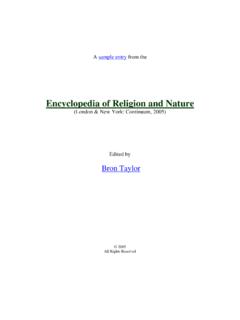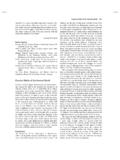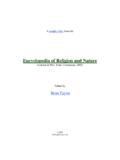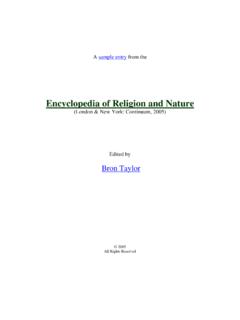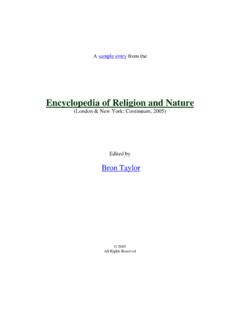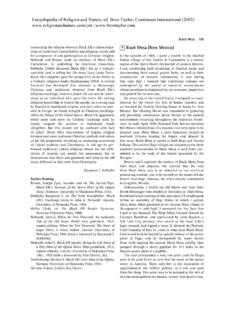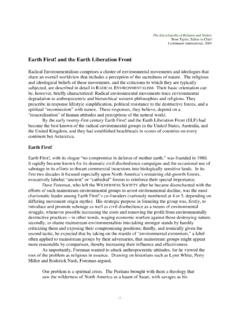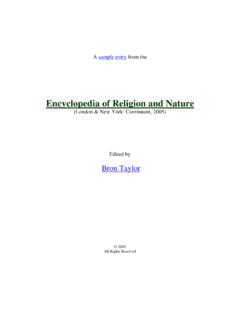Transcription of Encyclopedia of Religion and Nature
1 A sample entry from the Encyclopedia of Religion and Nature (London & New York: Continuum, 2005). Edited by Bron Taylor 2005. All Rights Reserved 42 American Indians as First Ecologists . Further Reading developing an imagery of nobleness. Best known was Smith, Nigel The Enchanted Amazon Rain Forest. Jean-Jacques Rousseau, who presented savage life as Stories from a Vanishing World. Gainesville, FL: Uni- simple, communal, happy, free, equal, and pure, and versity of Florida Press, 1996. ensured that Noble Indians would rule the second half of Slater, Candace. The Dance of the Dolphin. Chicago: The the eighteenth century as allegorical America or in other University of Chicago Press, 1994.
2 Genres. He and others mined the classics for ennobling See also: Dolphins and New Age Religion . thoughts that they applied unhesitatingly to the native people of the New World, and quickly linked the develop- ment of favorable virtues to la pure Nature . Many still SP American Indians as First Ecologists considered their own (French) civilization superior to any developed by the children of Nature in the New World;. The image of North American Indians as rst ecologists, indigenous people came up wanting in faith, laws, and conservationists, and environmentalists, which can be kings (ni foi, ni loi, ni roi). Ni foi meant, of course, that called the Ecological Indian, became dominant in the Religion was barely worthy of the name (as had also been 1960s.)
3 Today, many, including American Indians, accept it so for Columbus, who depicted Caribs as lacking in as an accurate representation of Indian behavior through Religion ). Yet while they denigrated these aspects of time. Yet the image has deep intellectual roots and has indigenous culture and institutions they also seized on gone through various iterations, from a generalized liberty and equal access to basic resources as characteristic Nature -dwelling noble indigenousness, through one of savage life and important virtues to emulate. Thus, emphasizing pragmatic skill in the environment, to contained in their observations of the New World was a today's full-blown Ecological Indian.
4 Critique of their home society. For example, Michel de Montaigne and Baron de Lahontan set the stage for The Noble Indian in Nature Rousseau by lauding natural New Worlders and in the From the moment they encountered indigenous people in next breath condemning French society. Lahontan even the Western hemisphere, Europeans classi ed them in invented a Huron Indian named Adario to critique the order to make them sensible. They made the exotic com- European scene and those who had stripped him of prehensible with familiar categories. In the process they property. As one historian remarked, many used the New reduced men and women to stereotypes, to caricatures, World as a stick with which to beat the Old.
5 Noble or ignoble, benign or malignant, rational or irrational, human or cannibal savages all. For centuries The Skilled Woodcrafter two polar images of Indians in the New World noble and The nineteenth-century inheritors of the tradition of the ignoble have clashed. Until recently, the Ignoble Indian Noble Indian in Nature include not simply Romantic ruled; a menacing, malignant image construing the Indian Nature poets but James Fenimore Cooper, the best-selling in the extreme as a bloodthirsty, inhuman cannibal akin to author from the 1820s through the 1840s and arguably the the Wild Man of European folklore. In contrast, the Noble most important gure in the nineteenth century for fur- Indian (or Noble Savage), never entirely absent the ther development of such imagery.
6 All manner of Indians peaceful, carefree, unshackled human; the wise, digni ed can be found in Cooper's works, especially the Leather- elder; the nostalgic romantic; the spiritual guide; the stocking series, of which Last of the Mohicans is best polished orator was and is a benign, often romantic, known today. The most famous are digni ed, rm, fault- image of people living innocent, vigorous, clean lives in a less, wise, graceful, sympathetic, intelligent, and remin- golden world of Nature . iscent of classical sculpture in their bodily proportions. Columbus was rst to ennoble the inhabitants of the In his portrayal of Noble Indians, Cooper was strongly New World when, on his second voyage, he wrote that he in uenced by John Heckewelder, the Moravian missionary had found the Islands of the Blessed and its natural and relativist sympathetic to the Lenape and their history.
7 Inhabitants a place and people in the European imagina- indeed some criticized Cooper for unrealistically noble tion. His readers were not surprised at least not those portraits in the school of Heckewelder.. for whom several mythic places originating in pagan Whereas for writers of an earlier day it was enough that or Christian tradition were linked in the imagination and Indians' lives unfolded in Nature , for Cooper what was collectively expressed ideas of earthly paradise, eternal weighty were Indian actions in Nature ; speci cally, their spring, or innocent life removed in space or time. An skill in the forests and prairies. Cooper's Indians demon- imagery traceable to these understandings remained strated competence and even transcendent skill in Nature .
8 Potent long after Columbus as writers invoked ancients In contrast, non-Indians (except the protagonist Natty like Tacitus or various classical analogs like the Scythians Bumpo) generally lacked such skills. Moreover, white men to render intelligible the native people of the New World. (except Natty) often wasted what they killed or otherwise Over two centuries, the French were without peer in were greedy. It is Natty, the conservationist, not some American Indians as First Ecologists 43. Indian, who has something to say about the gluttony of It ourished at the time of and was in tune with the whites and remarks, Use, but don't waste. There is one progressive conservation movement.
9 Notable exception: in forceful remarks in Last of the Some traits of Seton's Skilled Woodcrafter character- Mohicans, Magua, a Wyandotte Huron lumped with istic of Natty Bumpo rather than Cooper's Indians . Mohawks and other Iroquois as Mingoes, states passion- thriftiness, condemnation of waste can probably be ately that the Great Spirit gave Indians North America traced to the in uence of Charles Eastman (also know as ( this island ), forested and full of game, but then he Ohiyesa), who was active in scouting circles at Seton's also granted whites the Nature of the pigeon that is, time and consulted by Seton before the latter published his exploding numbers, tirelessness, and insatiable appetites Ideal Indian character traits.
10 Eastman was a Sioux Indian suited to control over the Earth. who took his maternal grandfather's (the soldier-artist, Magua, no Noble Indian, is one of the most infamous of Captain Seth Eastman) White Man's Road to college and Cooper's arch-demons, which substantially muddied medical school, and for nearly forty years (1900 1940). reception of his message about the Great Spirit or white was the most visible Native American writer and public people's avarice. For authority one needed Natty himself, speaker, producing best-selling books on his own life and the protagonist of heroic proportions (in part from taking Indian ways. Betraying the complexity in the origin of his on the anti-conservationists of the frontier) and Nature ideas, he paid homage not just to his Dakota grandparents herself, heroine of unsurpassed dimensions.
